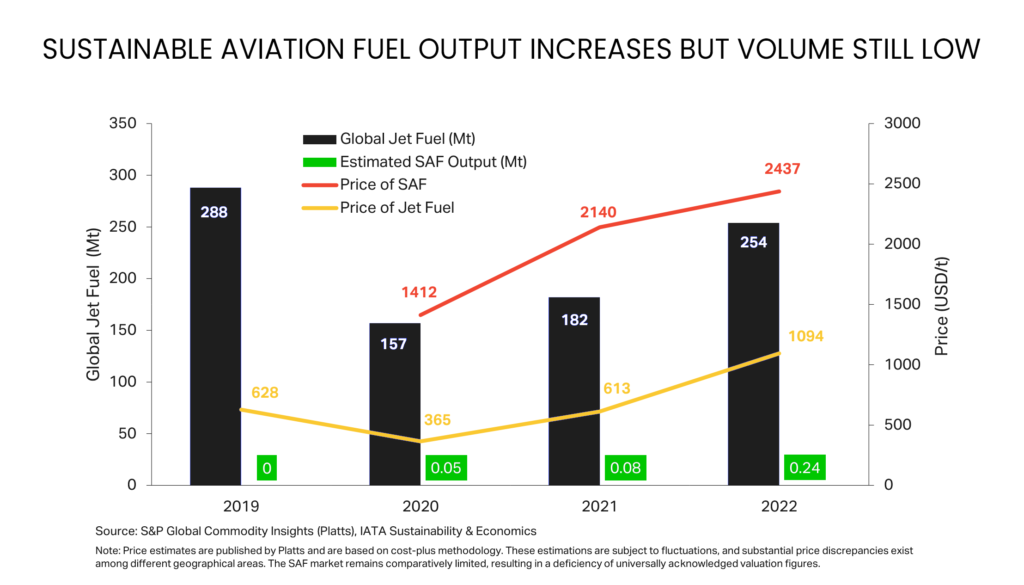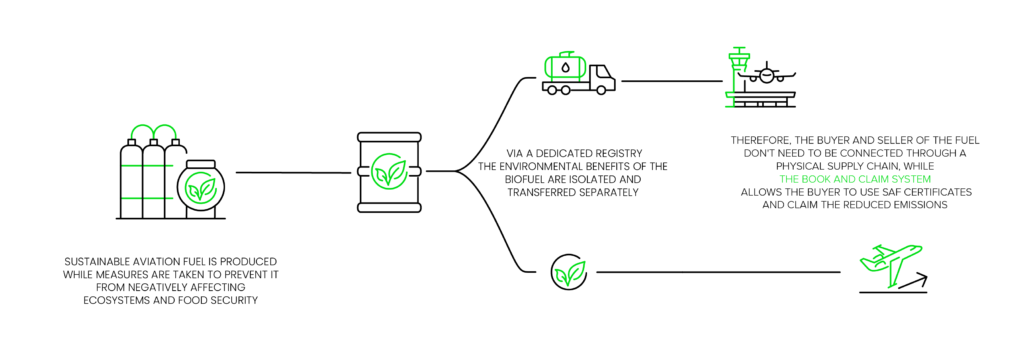Sustainable aviation fuel (SAF) is the most prominent opportunity for reducing emissions in hard-to-abate sectors such as shipping and the aviation industry. However, to prevent the negative effects of SAF on ecosystems and food security while producing it, the physical availability of SAF is often limited, and this biofuel is often out of reach for the ever-increasing market demand.
Consequently, the high price tag of SAF deflects many small local buyers, and more significant consumers will need to transport the physical fuel long distances from the production sites to use it. This transportation will eventually decrease the emission reduction potential, sometimes leading to even higher prices.

The SAF Book and Claim system offers a viable solution to these challenges, also known as SAF Credits or SAFc.
How does a Book and Claim system work?
Electricity providers were among the first to introduce the Book and Claim systems. All electricity, produced from renewable sources or not, is combined before getting to a power outlet. Hence, we can’t track who exactly uses the more sustainably produced electricity. This proved to be a challenge for consumers measuring their environmental impact and reducing CO2 emissions.
To solve this dilemma, electricity providers would “book” the renewable share of their productions so their customers could “claim” the green energy they have bought. For instance, if 40% of electricity sold had been sourced from renewable sources, every customer could claim the same thing regardless of the physical flow of the energy.
Accordingly, someone claiming the environmental benefits might not have even used any of the renewable energy portions of the electricity, yet as they have financially supported the process, the chain of custody model allows providers to de-couple these benefits from the physical product and transfer them separately via a dedicated registry.
We can apply the same logic to the sustainable aviation fuel supply chain as dedicated registries track and document the production and ownership of the physical fuel. After that, the environmental benefits of the Biofuel are isolated and transferred separately. Therefore, the buyer and seller of the fuel don’t need to be connected through a physical supply chain.
With the help of Book and Claim, the buyer does not physically burn the fuel, yet their purchase demonstrates market demand and propels long-term global growth. In return, they may claim the reduced emissions towards their voluntary Net Zero goals.

The Impact of SAF Book and Claim on the Aviation Industry
The deployment of SAF and the Book and Claim system is pivotal for the aviation industry’s efforts to reduce its carbon footprint. By allowing companies to claim the environmental benefits of SAF without having to integrate the fuel into their supply chains physically, the aviation sector can significantly reduce CO2 emissions, even when direct access to SAF is logistically or economically challenging.
Moreover, this system encourages the production of SAF by providing a mechanism for demand to be met with supply, even in a fragmented market. As commercial flights begin to incorporate more SAF into their fuel mix, the claim system serves as a crucial bridge between current fossil jet fuel usage and a future where aviation fuels are predominantly sustainable.
However, the success of this system hinges on robust chain of custody models to prevent double counting and ensure transparency. Such transparency not only fosters trust among stakeholders but also guarantees that emission reduction claims are accurate and verifiable.
Looking Forward
The transition to sustainable aviation fuel (SAF) represents a long-term commitment to environmental stewardship and carbon neutrality for the aviation industry. The Book and Claim system facilitates this transition by addressing the logistical and economic barriers associated with SAF deployment. By fostering an environment where supply chains are optimized for sustainability, aviation can make substantial strides in emission reduction.
As the industry moves forward, it will be imperative to continuously refine the Book and Claim systems, ensuring they are robust against fraud and effective in promoting genuine emission reductions. This evolution will require collaboration among all stakeholders—fuel producers, airlines, regulatory bodies, and environmental organizations—to ensure the sustainability and efficacy of aviation fuels in the long term.
In conclusion, the Book and Claim model stands as a testament to the innovative approaches being deployed in the fight against climate change. By decoupling environmental benefits from physical products, this system paves the way for more sustainable practices across industries, driving us toward a future where our carbon footprint is significantly reduced.






